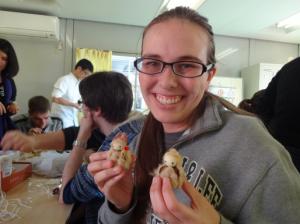This was my first study tour, and my first time visiting Iwaki. I live in Fukushima City, which has only been affected indirectly by the tsunami and Daiichi power plant disaster. I was interested in seeing the effects of the disasters for myself, and to see exactly how they check for radiation in Fukushima’s produce. This trip put any lingering fears about food safety here in Fukushima to rest for me. We visited a radiation testing facility near Koriyama city, where they explained how they check for radiation. While they can’t check every fruit or vegetable in the Prefecture, they do check every bag of rice and enough fruits and vegetables to make me feel comfortable. The radiation limits in Japan are also much lower than those in the United Sates- 100 Becquerel’s per kg, compared to 1,200 in the US. The many businessmen we talked to, however, said that despite their food’s safety, many people are reluctant to buy it just because it says “Fukushima”. One fish paste factory noted that their ingredients don’t even come from Japan- overfishing around Japan has ensured they have to import fish from the US or Southeast Asia- but people still won’t buy their product because their factory is in Fukushima. This trip showed me how much agricultural diversity there is in Fukushima! My favorite part of the tour was touring Tomato Land, a large greenhouse selling tomatoes and peppers. We were able to eat and pick as many tomatoes as we could! There are few things better than fresh, warm cherry tomatoes, and I was stuffed afterward. We also sampled different kinds of fish paste, kamaboko, which the factory was trying to sell in Tokyo. We also picked cotton that a charity has started growing on abandoned rice paddies. It was hard work, and I wouldn’t want to do it all day, but it was a lot more fun than spending all day in the teacher’s room! Besides the business tours and the delicious food, I learned about the people and history of Iwaki. The part of the tour that most affected me was visiting an area damaged by the tsunami. The area near the ocean is still empty except for some foundations and a shrine facing the sea. We met some of the people who had lived there, and now run a small street of shops a kilometer from the devastated area. I really admired that they were still trying to rebuild their neighborhood and homes, even though they faced the wreckage every day. We also visited a beautiful temple in Iwaki, surrounded by Heian-era gardens. The fall leaves were a beautiful red, and made a wonderful conclusion to the tour. Iwaki, and Fukushima in general, have so much more to offer to Japan and the world than the disasters that hit almost three years ago. Please do not forget the farmers, charities, and normal citizens that are continuing to recover. |  |
| Summary |







